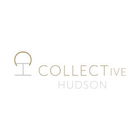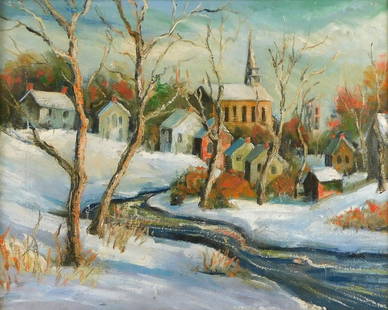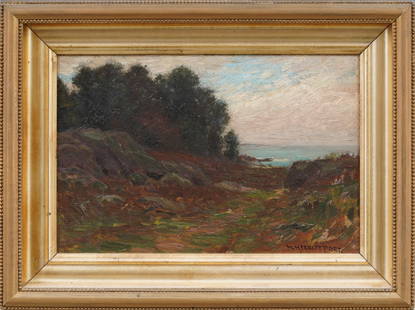
Hal Robinson signed, 'Winter Landscape'. Oil on Canvas
Similar Sale History
View More Items in Paintings
Related Paintings
More Items in Impressionist Paintings
View MoreRecommended Art
View More











Item Details
Description
Hal Robinson , 'Winter Landscape'. Oil on Canvas Painting
Hal Robinson (British/American,1867-1934) American Impressionist 'Winter Landscape', oil painting on canvas, signed lower right 'Hal Robinson'.
Canvas - 22" high x 28" wide. Frame - 28 1/2" high x 34 1/8" wide.
The following biography was researched, compiled, and written by Geoffrey K. Fleming, Executive Director, Huntington Museum of Art, Huntington, WV: Harry Robinson, aka 'Hal Robinson' was a landscape painter in oil and watercolor. Though long considered an artist who was born and raised in America, his given name was not Hal, but rather, Harry. He was born in Leominster, County Hereford, England. Though American sources often report his birth year as 1875, according to his parish baptism record he was actually born in 1867. He should not be confused with the American artist Harry A. Robinson or the British painter Harry W. Robinson. Exactly where he received his artistic training remains unclear. When he arrived in the united states in 1893 he already listed his profession as artist, indicating that he was already actively engaged in his chosen profession. By the early 1890's it appears that his parents were deceased, and he and his brother decided to emigrate to America. They arrived in new york city on the 17th of April 1893.
As a professional artist in the us, Robinson does not ever appear to have used his given name. Instead he chose to use a common nickname for that given name, Hal; and he chose to always sign his paintings 'Hal Robinson'. The reason for his change of name is unknown. Perhaps it sounded more 'American' to him. While it was unusual to exhibit at a major venue prior to having participated in a few smaller gallery shows, the first recorded exhibit Robinson participated in was at the national academy of design in 1896. Thereafter it took some time before he appears as an exhibitor again, though it is not clear why. He returned to the academy in 1909, and in 1910 participated in a group exhibition held at the art rooms of James Rice in new york city (Robinson designed a group of envelope covers depicting an artist at work and fishermen cavorting which he sent to Rice during this period).
From this point forward, he would be a regular exhibitor in new york and elsewhere along the eastern seaboard. In addition to the national academy, he participated in exhibitions at the corcoran gallery of art in washington, d.c. and submitted works to the carnegie institute in pittsburgh in 1911 (unfortunately, both the paintings he submitted were rejected). He was also a regular exhibitor at a number of important art galleries, including Katz and Snedecor galleries in new york city, and at the Lauterbach Art Gallery in buffalo, new york. He was also a participant at the inaugural exhibition of the recently formed group, allied artists of america, in 1914. Snedecor Gallery (later to become Babcock Galleries in 1918) seems to have been his most supportive dealer during the teens, including him in his first exhibition in 1912 and continued to show his work regularly through at least 1916. He received a solo show at the gallery in 1914 which was chiefly composed of scenes painted in western Connecticut (he apparently favored locations close to Nyack, New York), and where a reviewer noted that the “qualities which make them appeal are their directness – all were painted from nature instead of from sketches.." At least one work was of a new york scene, and depicted the grounds of Samuel Untermyer’s House Greystone (the former home of Samuel J. Tilden) in hudson, new york. In 1916, Robinson again participated in a number of exhibitions – including at the Marshall Field Art Gallery in Chicago – and then the following year something happened – he disappeared. For nearly a decade he vanished from the art world altogether. Part of his vanishing can be explained by the fact he had moved his residence from new york city to the lower part of upstate new york. He appears first as a resident of pawling, located in Dutchess County, n.y., in 1925 and by 1930 was residing in carmel, located in putnam county. He finally settled in the small village of mahopac falls, also located Putnam County, new york, sometime after 1930. However, it is entirely unclear why he made this move and why he chose to no longer participate in the regular, public exhibition of his work. Whatever the reason, from the point of his move to upstate new york ,Robinson only appears here and there as an exhibitor. Records in mahopac reveal little about his activities in the community, other than he was a well-known artist who had a successful career. Harry Robinson died after suffering a heart attack at mahopac falls on Saturday the 18th of March 1933, at the age of sixty-five.
He was perhaps best known for his works that were inspired by the impressionist movement, and his oils are usually characterized by a rich impasto. But he was just as comfortable working with a tonalist palette when the need arose, and many of his works have a soft, atmospheric quality to them. While on occasion he did depict urban scenes (primarily in and around new york city), many of his paintings offer a view of rural America. Scenes drawn from the heart of the wooded landscapes of lower new york state were a recurring theme for him, perhaps because of his upbringing in england, where the majority of the great forests had been swept away by the advent of the industrial revolution. Though many of the titles of his works are generic, some reveal the locations where they were painted, such as 'Farmington River, CT,' 'Dawn, Darien, Conn.' and 'The Ice-Bound Hudson,” Views along the hudson and other rivers appear to have been a particular favorite, as were the bridges located around New York City.
Hal Robinson (British/American,1867-1934) American Impressionist 'Winter Landscape', oil painting on canvas, signed lower right 'Hal Robinson'.
Canvas - 22" high x 28" wide. Frame - 28 1/2" high x 34 1/8" wide.
The following biography was researched, compiled, and written by Geoffrey K. Fleming, Executive Director, Huntington Museum of Art, Huntington, WV: Harry Robinson, aka 'Hal Robinson' was a landscape painter in oil and watercolor. Though long considered an artist who was born and raised in America, his given name was not Hal, but rather, Harry. He was born in Leominster, County Hereford, England. Though American sources often report his birth year as 1875, according to his parish baptism record he was actually born in 1867. He should not be confused with the American artist Harry A. Robinson or the British painter Harry W. Robinson. Exactly where he received his artistic training remains unclear. When he arrived in the united states in 1893 he already listed his profession as artist, indicating that he was already actively engaged in his chosen profession. By the early 1890's it appears that his parents were deceased, and he and his brother decided to emigrate to America. They arrived in new york city on the 17th of April 1893.
As a professional artist in the us, Robinson does not ever appear to have used his given name. Instead he chose to use a common nickname for that given name, Hal; and he chose to always sign his paintings 'Hal Robinson'. The reason for his change of name is unknown. Perhaps it sounded more 'American' to him. While it was unusual to exhibit at a major venue prior to having participated in a few smaller gallery shows, the first recorded exhibit Robinson participated in was at the national academy of design in 1896. Thereafter it took some time before he appears as an exhibitor again, though it is not clear why. He returned to the academy in 1909, and in 1910 participated in a group exhibition held at the art rooms of James Rice in new york city (Robinson designed a group of envelope covers depicting an artist at work and fishermen cavorting which he sent to Rice during this period).
From this point forward, he would be a regular exhibitor in new york and elsewhere along the eastern seaboard. In addition to the national academy, he participated in exhibitions at the corcoran gallery of art in washington, d.c. and submitted works to the carnegie institute in pittsburgh in 1911 (unfortunately, both the paintings he submitted were rejected). He was also a regular exhibitor at a number of important art galleries, including Katz and Snedecor galleries in new york city, and at the Lauterbach Art Gallery in buffalo, new york. He was also a participant at the inaugural exhibition of the recently formed group, allied artists of america, in 1914. Snedecor Gallery (later to become Babcock Galleries in 1918) seems to have been his most supportive dealer during the teens, including him in his first exhibition in 1912 and continued to show his work regularly through at least 1916. He received a solo show at the gallery in 1914 which was chiefly composed of scenes painted in western Connecticut (he apparently favored locations close to Nyack, New York), and where a reviewer noted that the “qualities which make them appeal are their directness – all were painted from nature instead of from sketches.." At least one work was of a new york scene, and depicted the grounds of Samuel Untermyer’s House Greystone (the former home of Samuel J. Tilden) in hudson, new york. In 1916, Robinson again participated in a number of exhibitions – including at the Marshall Field Art Gallery in Chicago – and then the following year something happened – he disappeared. For nearly a decade he vanished from the art world altogether. Part of his vanishing can be explained by the fact he had moved his residence from new york city to the lower part of upstate new york. He appears first as a resident of pawling, located in Dutchess County, n.y., in 1925 and by 1930 was residing in carmel, located in putnam county. He finally settled in the small village of mahopac falls, also located Putnam County, new york, sometime after 1930. However, it is entirely unclear why he made this move and why he chose to no longer participate in the regular, public exhibition of his work. Whatever the reason, from the point of his move to upstate new york ,Robinson only appears here and there as an exhibitor. Records in mahopac reveal little about his activities in the community, other than he was a well-known artist who had a successful career. Harry Robinson died after suffering a heart attack at mahopac falls on Saturday the 18th of March 1933, at the age of sixty-five.
He was perhaps best known for his works that were inspired by the impressionist movement, and his oils are usually characterized by a rich impasto. But he was just as comfortable working with a tonalist palette when the need arose, and many of his works have a soft, atmospheric quality to them. While on occasion he did depict urban scenes (primarily in and around new york city), many of his paintings offer a view of rural America. Scenes drawn from the heart of the wooded landscapes of lower new york state were a recurring theme for him, perhaps because of his upbringing in england, where the majority of the great forests had been swept away by the advent of the industrial revolution. Though many of the titles of his works are generic, some reveal the locations where they were painted, such as 'Farmington River, CT,' 'Dawn, Darien, Conn.' and 'The Ice-Bound Hudson,” Views along the hudson and other rivers appear to have been a particular favorite, as were the bridges located around New York City.
Condition
Very good. Painting has been relined. All items are sold 'as is,' without warranty or guarantee of any kind. By participating in this sale, buyers acknowledge that they accept items based on their current condition, irrespective of any descriptions, discussions, or reports provided by us. We encourage potential buyers to inquire about any specific item conditions before making a purchase, but please note that all sales are final.
Buyer's Premium
- 30%
Hal Robinson signed, 'Winter Landscape'. Oil on Canvas
Estimate $1,200 - $2,400
20 bidders are watching this item.
Get approved to bid.
Shipping & Pickup Options
Item located in Kingston, NY, usShip with LiveAuctioneers
Arrange Your Own Shipping
Payment
Accepts seamless payments through LiveAuctioneers

TOP




















![Hal Robinson, Landscape - Oil on Canvas: Turn of the century American landscape. Signed bottom right. [29 1/2" H x 24 1/2" W; Frame: 43 1/2" H x 28 1/2" W]. Multiple tears, sold "as is".](https://p1.liveauctioneers.com/1221/75115/39334246_1_x.jpg?height=310&quality=70&version=1436995602)

























































